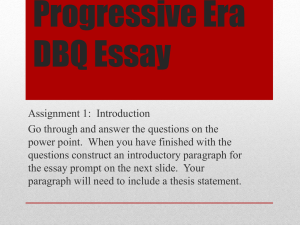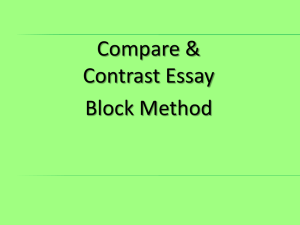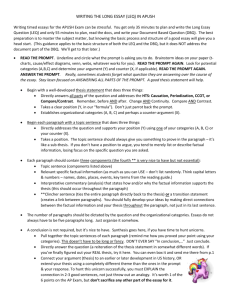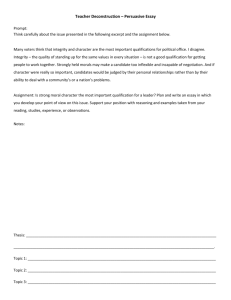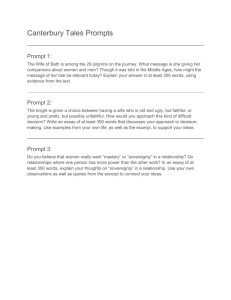Some quick notes on writing GOOD historical essays (LEQs)
advertisement
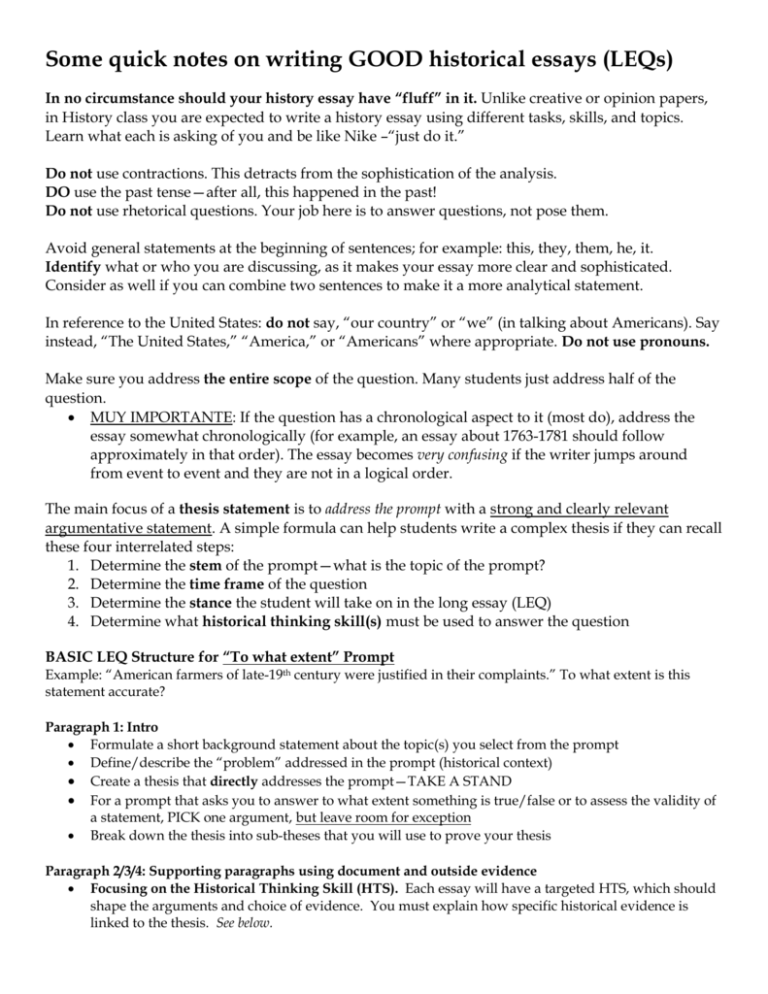
Some quick notes on writing GOOD historical essays (LEQs) In no circumstance should your history essay have “fluff” in it. Unlike creative or opinion papers, in History class you are expected to write a history essay using different tasks, skills, and topics. Learn what each is asking of you and be like Nike –“just do it.” Do not use contractions. This detracts from the sophistication of the analysis. DO use the past tense—after all, this happened in the past! Do not use rhetorical questions. Your job here is to answer questions, not pose them. Avoid general statements at the beginning of sentences; for example: this, they, them, he, it. Identify what or who you are discussing, as it makes your essay more clear and sophisticated. Consider as well if you can combine two sentences to make it a more analytical statement. In reference to the United States: do not say, “our country” or “we” (in talking about Americans). Say instead, “The United States,” “America,” or “Americans” where appropriate. Do not use pronouns. Make sure you address the entire scope of the question. Many students just address half of the question. MUY IMPORTANTE: If the question has a chronological aspect to it (most do), address the essay somewhat chronologically (for example, an essay about 1763-1781 should follow approximately in that order). The essay becomes very confusing if the writer jumps around from event to event and they are not in a logical order. The main focus of a thesis statement is to address the prompt with a strong and clearly relevant argumentative statement. A simple formula can help students write a complex thesis if they can recall these four interrelated steps: 1. Determine the stem of the prompt—what is the topic of the prompt? 2. Determine the time frame of the question 3. Determine the stance the student will take on in the long essay (LEQ) 4. Determine what historical thinking skill(s) must be used to answer the question BASIC LEQ Structure for “To what extent” Prompt Example: “American farmers of late-19th century were justified in their complaints.” To what extent is this statement accurate? Paragraph 1: Intro Formulate a short background statement about the topic(s) you select from the prompt Define/describe the “problem” addressed in the prompt (historical context) Create a thesis that directly addresses the prompt—TAKE A STAND For a prompt that asks you to answer to what extent something is true/false or to assess the validity of a statement, PICK one argument, but leave room for exception Break down the thesis into sub-theses that you will use to prove your thesis Paragraph 2/3/4: Supporting paragraphs using document and outside evidence Focusing on the Historical Thinking Skill (HTS). Each essay will have a targeted HTS, which should shape the arguments and choice of evidence. You must explain how specific historical evidence is linked to the thesis. See below. Create a strong sub-thesis that addresses a part of the prompt/thesis—beyond the basic statement by adding a “how/why” clause Use a FACT with interpretive commentary (explain WHY or HOW this is important in relation to the prompt/thesis) Repeat previous step twice more Write a clincher sentence at the end of the support paragraph. This should relate back to the thesis and acts as a transition to the next paragraph Conclusion: the SYNTHESIS paragraph Synthesize the topic sentences and directly relate them back to the question. Make sure that you maintain the theme of proving your thesis as an extreme (pro/con) with room for exceptions. THEN choose one of the following: Information that might refute your thesis—BUT you will briefly explain how your argument is more valid How the items/argument you presented were the result of earlier events OR resulted in later, similar events (i.e., Reconstruction and the Civil Rights Movement) Historical Thinking Skill (HTS) Causation. Describe causes AND/OR effects of a historical development and analyze specific examples that illustrate causes AND/OR effects of a historical development. What were the major causes and consequences (effects) of an event? What were the most important causes and effects of an event? Comparison. Describe similarities AND differences among historical developments, providing specific examples AND analyze the reasons for their similarities AND/OR differences OR, DEPENDING ON THE PROMPT, evaluate the relative significance of the historical developments. What were the major similarities and differences between the two events? Are there more similarities or differences and why? Continuity and change over time. Describe historical continuity AND change over time, and analyze specific examples that illustrate historical continuity AND change over time. What were the major patterns of continuity and change? Was there more continuity or change over the time period? Periodization. Analyzes the extent to which the historical development specified in the prompt was different from AND similar to developments that preceded and/or followed, providing specific examples to illustrate the analysis. Evaluate whether an event was a turning point or major marking period in history. Note what it was like before and after that development.
